
52 minute read
Entrepreneur: Speed Bancroft 27 Business Lunch: Bin 77 Bistro 52
1 Key to Success
“There are many tools online to connect you with venture capital firms and angel investors. I’ve pitched probably 2,000
to 3,000 times and it’s changed my
perspective on how I look at funding. You have to get feedback and pivot— networking is very important.”
Speed Bancroft
FOUNDER, SPEEDY EATS
FOOD AUTOMATION
What they do:
Fully automated food service
Website:
Speedy-eats.net SPEED BANCROFT WAS inspired to research food automation technology after a sour experience with a fast-food worker in a drivethru window in north Louisiana in 2015. He had recently sold his stake in The Outdoor Shopper, a televised shopping show that he started in 2009, and was in an “idea creation phase” of life. For the next two years, he traveled to shows learning about food and automation technology and he developed his own bench-model prototype of a hamburger robot. Since then, he’s pivoted to an automated pizza concept and a fridge concept that serves a variety of items. “It’s all about raising capital,” Bancroft says. “Raising capital is difficult. You have to be tenacious about it and can’t have quitting in your mind—ever.”
As of December, Bancroft estimates Speedy Eats has raised about $825,000—more than $330,000 of which came through online crowdfunding. Bancroft expects to open his first automated restaurant concept, Speedy Eats Fridge, in the spring, with plans to install the fridge outside of The House, a bar in Tigerland, and serve burritos, wraps, subs and nachos. While it’s designed as a walk-up concept, he plans to design future ones as drive-thrus. —By Holly Duchmann • Photography by Don Kadair

THE STEAK AND FRITES AT BIN 77 is the perfect meal on a chilly January afternoon while those still sticking with their New Year’s resolutions should consider the Thai salad, which can be ordered as either a side or as an entrée.
Bin 77 Bistro

BY MAGGIE HEYN RICHARDSON
PHOTOGRAPHY BY COLLIN RICHIE
Address: 10111 Perkins Rowe, Ste. 160 Phone: (225) 763-2288 Website: bin77.com Cuisine: Modern American Partners: Kelwin and Linda Clark and Brian and Tiffany Dykes; culinary director Jonathan Breaux Scene: Wine-centric eatery in Perkins Rowe Pricing: $$
In Bin 77’s elevated steak and frites, flat iron steak is marinated and cooked first by sous vide before a quick trip to the grill. Drizzles of veal and herb aioli add creamy richness while chimichurri brings tangy pop. Any sauce remaining is great for dragging the accompanying crisp French fries. The meal feels right for blustery January, but the restaurant has plenty of salad options for resolutioners. The Thai features crisp greens and cabbages, pickled carrots, fresh herbs, peanuts and wontons in spicy peanut dressing. Order it on the side or as an entrée.


What will be the biggest news in 2023?
The ROUNDTABLE

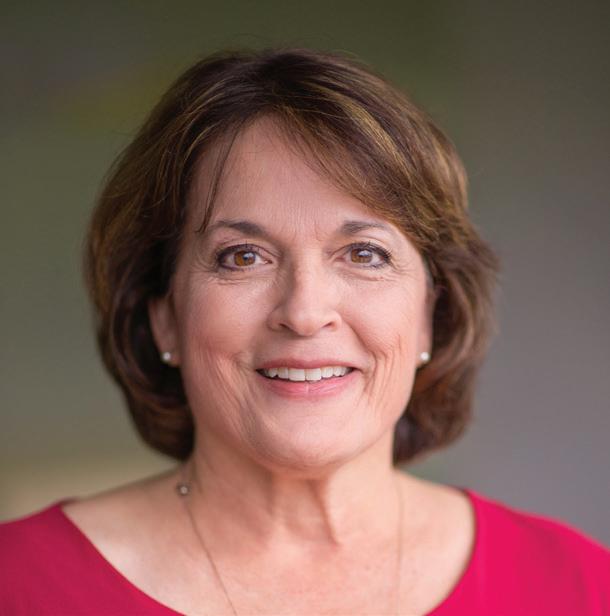
Six Baton Rouge thought leaders look to the future and share their insights on business and community concerns in the Capital Region.


What new tech will you deploy? How has the Great Resignation changed your company?
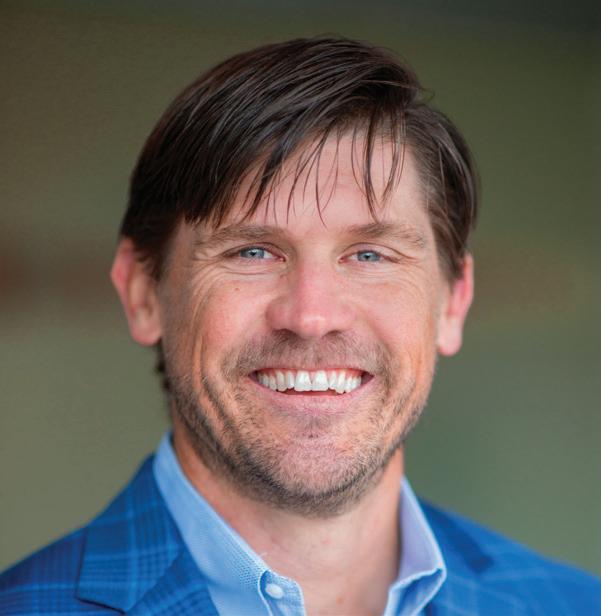
SPONSORED BY:
MEET THE ROUNDTABLE PARTICIPANTS
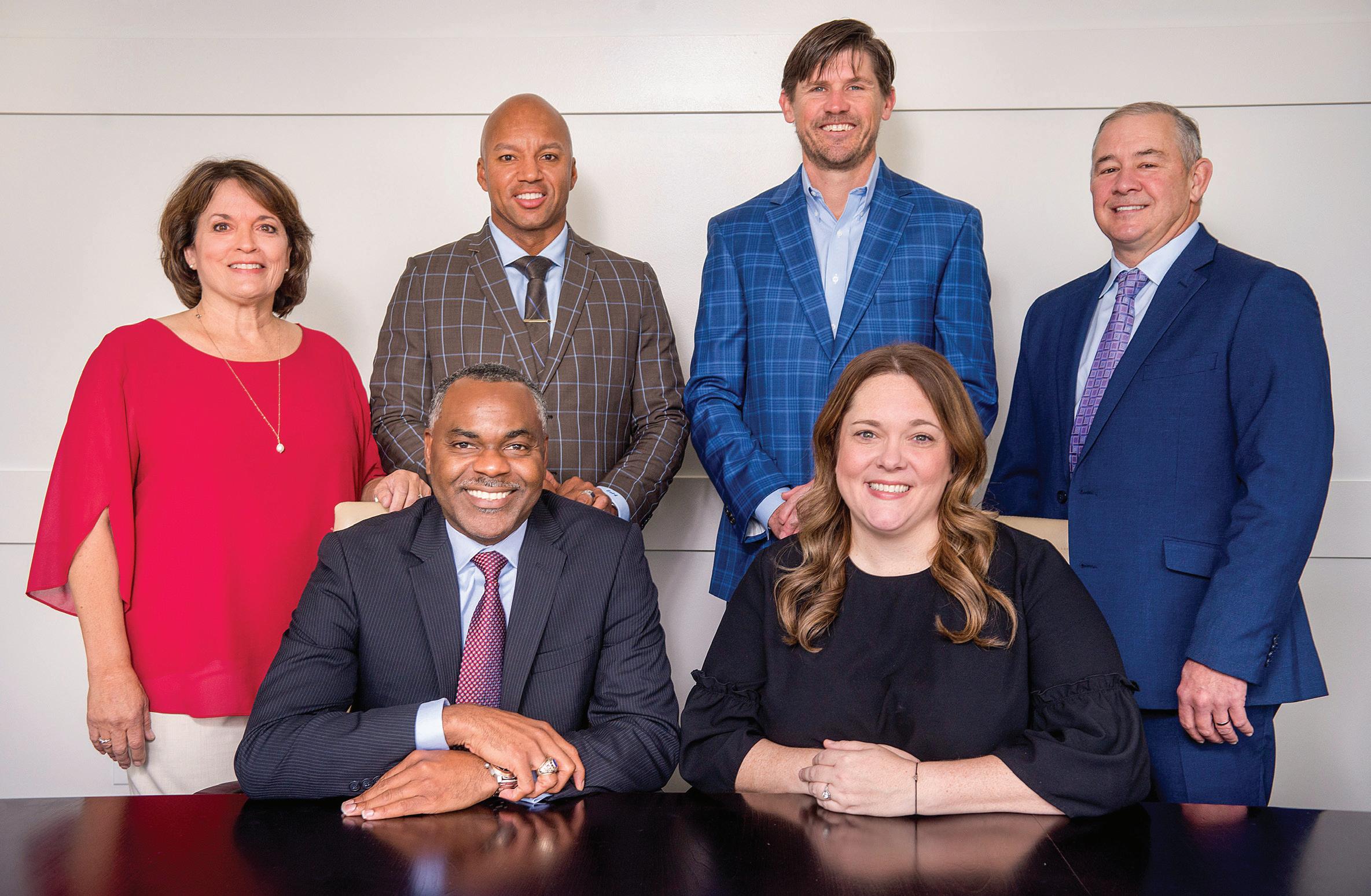
Kathy Trahan
President/CEO Alliance Safety Council
Craig Stevens
Owner/Founder Genesis 360, LLC
Lionel Johnson Jr.
Mayor St. Gabriel, LA
Carter Leak IV
President/CEO Bank of St. Francisville
Zelma Frederick
Baton Rouge Office Managing Attorney McGlinchey
Chuck Daigle
CEO Ochsner Baton Rouge, Lake Charles & North Louisiana
Let’s Talk About It
BATON ROUGE CONTINUES to feel the effects of hardships and challenges from recent years— the pandemic, inflation, mass job resignations—but recovery seems to be just around the bend.
For the past five years, Business Report has invited influential thought leaders to a unique roundtable to gather their opinions on some of the most critical issues facing our community. Topics include the economy, technology, quality of life, workforce issues, diversity and more. In these pages, leaders highlight the challenges of the past year, how they managed them, and how they hope to create a new and stronger vision for 2023.
Comments made during the roundtable have been edited and condensed for clarity and for space. Read and share the online version at businessreport. com/2023Roundtable.
We are having to do more with less people and things are changing so quickly ... I think the biggest issue is getting people tooled for new jobs and doing a gap analysis, helping and giving them good information, aggregating a lot of content, helping them make choices on where they should be going and what they should be doing. Our parents taught us to go to college and that you can be anything you want to be. I think we really need to work backward. Many universities chase grant funding that is important to research, but it doesn’t directly serve the local workforce community. Paying attention to our local workforce and helping them find those opportunities to raise their standard of living and help them navigate all the complexities that are going on right now, creating a way to integrate the information, the pipeline, the people. A lot of people are throwing darts at it right now. Everyone has great systems and data, but we are just now integrating it in a way that’s creating intelligence for what we need to be doing next.
—Kathy Trahan We are still coming out of the post-pandemic world. Infrastructure, economic disparity, education—it is all a conglomerate. At the end of the day, there are a lot of great efforts in the public, private and nonprofit sectors to minimize and close those workforce gaps. Right now, we are all so splintered ... we need to collaborate and make progress towards one thing. If it’s finding gaps in education and jobs and where different skillsets are needed to make progress, then that is what we need to do. But we must have collective impact and come together because the problems are bigger than any single organization.
—Zelma Frederick
In my world, it is infrastructure, specifically transportation and stormwater infrastructure. We do know there is progress on the LA 415, I-10, and I-12 widening, and the replacement of the intracoastal bridge. And with LA 30 widening and a new MRB hopefully coming soon, we are looking at a lot of construction happening at the same time in a small vicinity. And of course, any progress made on rail infrastructure between Baton Rouge and New Orleans is a win. As it relates to stormwater infrastructure, the one piece missing is bringing all parties together. The state has made some leeway but it still remains a competitive venture rather than a collaborative venture. I believe that if Iberville, EBR, Ascension and Livingston—all of them at the table looking at infrastructure issues, great progress could be made holistically rather than in pockets or in silos.
—Lionel Johnson
What is the most pressing issue facing South Louisiana and Baton Rouge?

We have got to do a better job of letting our students in the educational system know what is out there, so we can get an earlier entrance and career interest in the healthcare fields. Most high school students do not know what a medical laboratory scientist is, or what an imaging technologist is. There are some great jobs out there and great careers that support the economies and families that our kids just don’t know about. So the question is how do we keep our young talent here within Louisiana? Secondly, I think we have got a great opportunity with economic development. We have some great projects on the horizon. Those projects, economic development, and a healthy workforce provide more opportunities, more resources, and more engagement. In order to solve some of the problems that we have, we have got to have a strong economic fabric. I think we have a great opportunity at this point in time moving forward while the nation is in a more difficult time.
Iwas playing golf with somebody a couple of weeks ago and he said he wanted his daughter to go to LSU for college but she wanted to go to Alabama. Then there was the shooting that happened off of Government Street and he said, “You know what, Alabama doesn’t look too bad after all.” So my thought was if this one individual is thinking that way, how many more people are thinking that way? And how does that affect my business? The short-term fix, I think, is doing what the military has done for years and that is to use technology. Why don’t we have more cameras in more places? Why are we not using drones? The police department says it’s 20% of the people who are causing 80% of the crimes—it’s just a matter of catching them. So why don’t we just implement more technology? The long-term fix is how do we keep families together? Statistics show that rising crimes are parallel to the rising number of families abandoned by fathers. Scholars indicate that a 10% increase in children living in single-parent homes typically leads to 17% juvenile crime. Criminals capable of sustaining marriage gradually moved from a life of crime after they get married. The father’s involvement in raising children is a great buffer against a life of crime. So I think that we have to educate young adults on the adverse effects of having kids out of wedlock. This is not a Roe vs. Wade or pro-life or pro-choice issue. We educate kids on the use of drugs and alcohol. Why do we not educate them on the potential broader issues is of having kids prior to marriage? That’s the short-term and long-term fix for me, realizing that crime is the elephant in the room for across our nation.
—Chuck Daigle
Ilive in St. Francisville and I can’t tell you how many people over the last two years have come to me and said, “I want to move to St. Francisville. I want to move away from the crime.” That’s the number one issue for Baton Rouge in my opinion, and I could not agree more with what Craig says. I think he hit the nail on the head. It’s family, it’s the church and it’s the community schools. We have got to figure out how to make those things a priority. That’s what holds a community together and builds up men and women to see their purpose. If they see purpose and opportunity, then they will have hope and will thrive.
As a country, we have the ability, capacity and the resources to move towards sustainable energy, but 80% of the globe still needs fossil fuel to survive. Many countries couldn’t heat an incubator for a newborn baby or provide electricity to hospitals or schools without it. The rising interest rates and inflation are being exacerbated by logistics issues that are hampering both manufacturing and project completion thereby forcing companies to delay paying their bills until they can complete the jobs and bill for the work. This in turn is creating a climate where bid escalation on future projects to compensate for cash flow issues is becoming the norm. With respect to the labor market, we are seeing interest in receiving transitional skills for the energy sector. How do plumbers, pipefitters and electricians get trained and tooled up to build, maintain and repair the wind and solar farms? What about the increasing need for electric vehicle charging stations? It’s all about balancing competing priorities. Our goal is to help soften some of the logistics issues by helping workers learn any place and anytime with mobile job aids and performance support tools. We are working to give the industries we serve the support they need when they need it and where they need it as opposed to forcing the workers to travel. We hope to keep our local labor force competitive.
—Kathy Trahan
Inflation and recession. I know that is in the forefront of everybody’s mind and obviously, with the stand the Federal Reserve is taking with increasing interest rates, it can change the economic picture pretty quickly. Economist Loren Scott says the Capital Region should remain in pretty good shape and not see many of the recessionary issues that the broader economy is going to see. We have seen layoffs already with national technology firms and that is likely going to continue, but I am hopeful and positive about our local economy. Look at Europe and what they pay for natural gas and the problems they are having with geopolitical issues compared to the natural gas pricing in the U.S. The amount of investment from sources from out of the country coming into south Louisiana and what that does for the local economy, trucking jobs, and everything else was a big “aha” moment when Loren laid all that out. I believe it has a positive impact on us. IIn the coming year, we will continue to see new regulations and laws about cryptocurrency, cannabis, and a focus on green energy. Our firm has recently gotten into the cannabis industry. We opened a Seattle office with a dynamic and energetic leader in the industry. Despite being based in Seattle, she is doing a lot in Louisiana, because federal and state laws are still out of step when it comes to marijuana. What’s interesting about this industry is that it is not solely about cannabis. It’s about companies who happen to be “touching” cannabis and how that touches everything that we are all doing already. It’s touching banking, as these entities need loans and banking products to facilitate their business. It’s touching employment, when workers with a medical marijuana prescription fail a drug test. For cryptocurrency, what happens when your employee wants to be paid partially in cryptocurrency? That hits the tax world. Who is going to pay the taxes on that? Do you value it at the time of the transaction? Do you value it at some point in the future time? In the energy sector, we are watching legacy industry giants adapt to green energy, monitoring the complexities of things like carbon capture and excitement of new offshore wind farms.
—Zelma Frederick
In your individual sectors, what will be the biggest news in 2023?

The interest rate hike—its pros and cons, its positives and negatives on both sides. There’s Newton’s law. Every action has an equal and opposite reaction. So in my space, the negative effect is that the cost of borrowing money has gone up. If you need to borrow money to expand or buy new equipment, that is costing you more money today than it did two weeks ago. The positive side ... the demand is going down on construction materials. We needed the demand to go down so the prices would go down. They probably won’t go to the pre-pandemic level but we are seeing decreases in prices. In the IT sector, the positive is that you have big tech laying off thousands of people whether it is Twitter or Meta. Amazon announced that 10,000 people are being laid off. That’s good for small IT companies like us where we gobble some of that talent even if they are in a remote location and pay a fraction of the salary that big tech is paying them. So I think that the opportunities and the wins for us are being able to get some really good IT talent.
—Craig Stevens
—Carter Leak IV
We will continue to promote our Healthy State initiative. Part of our goal is to get Louisiana off of 49th and 50th in health status and rankings. Many of these things are lifestyle behaviors and educational issues, whether that is smoking or obesity or infant mortality. We serve as a catalyst to get others in the state to promote more healthy living, more preventative health, and lifestyle changes. On the other side of that from a statewide and a national perspective, we are really having to go back to the workforce development piece within healthcare. Coming out of the pandemic, the healthcare system has leveled out in terms of not having the acute spikes in Covid cases and death and so much uncertainty, but now we are faced with a workforce issue. The average age of a nurse, for example, going into the pandemic, was about 47 years old. Many folks have retired. We have got a compounding aging population that needs more care and so we are dealing with a pretty acute workforce shortage which is causing labor costs to go up significantly. If you look at 2019 versus 2022 on a statistical basis, our labor costs for taking care of somebody are up 43%. We are 70% government-funded and so it’s going to take a while for the system to adjust in terms of the amount of reimbursement that flows to the system versus the cost to the system. Our role is to solve some of that through innovation and technology ... to continue to try to deal with the workforce shortage but also to continue our responsibility to keep the quality of care improving while we lower the cost. L ook for more announcements of industrial modernization and plans to improve efficiency. President Biden announced a plan for the production of materials used in manufacturing batteries for electrical vehicles. Koura of St, Gabriel is set to receive $100 million from USDOE. More announcements like that— industries modernizing and reshaping their facilities, all with the idea of producing more environmentally friendly products. The other big thing for 2023 is municipal elections in the spring. The mayor and council will pave the way for what happens in St. Gabriel specifically, and then later in the fall, we will have our state elections. Certainly this will have an impact over the next four years and beyond.
Microsoft Teams has allowed us to share information so being in different locations is a lot easier. It has made it more efficient and easier to actually have real conversations. It has been a game-changer in a positive way. We are also working with our core providers and planning an upgrade to all of our technology over the next several years. Technology is a constantly evolving and must be designed to simplify the lives of our customers and employees.
—Carter Leak IV
It’s a
For us, it is figuring out what the customer needs from a technology perspective. In the chemical industry, one of our clients performed their own safety training which involved watching a computer screen just like they have been doing for several years, and answering certain questions at the end. We have been able to provide them with software where they can use virtual reality headsets. For example, the employee is on a scaffold and it is not stable, and you give them the opportunity to show what kind of decision they are going to make. Are you going to take your safety harness and attach it to something? It gives them the real-time effects of what happens if they make the wrong decision. You visually see yourself falling to the ground with these headsets, so it really takes the safety piece to a whole different level. You feel the experience and the reality of what happens if you make the wrong decision. Those are the kinds of things that are new and exciting.
—Craig Stevens
The veteran-owned Genesis 360 provides innovative facilities management services, from large scale expansion projects to small repair and maintenance tasks.
It’s a
We continue to refine some of our remote monitoring with chronic disease management for those patients who qualify, whether it’s hypertension or diabetes—and the results have been pretty phenomenal in terms of keeping people at their controlled rates and keeping them healthy. All that data converts and goes to a care team every day. That continuous monitoring lets us make changes in real-time without a visit to the provider’s office and keeps people out of the emergency room. We continue to invest in those. We also have Connected MOM digital technology. It’s for pregnant women and it monitors blood pressure, fetal heart tones, all of those things. Again, it gives continued connection with the care team on an ongoing basis. We are working on fall risk technology (for elderly people) connected to smart phones and Apple watches. We are working to put that back into our MyOchsner app to make sure that we are making it available to seniors or others at risk for falling. I think home monitoring will be a big growth area for us. It’s effective and cost-efficient.
—Chuck Daigle
What technology or innovation will you be using in the new year?

The Alliance Safety Council’s Emerging Technologies Center provides an environment conducive to design thinking and development and delivery technologies that transform the adult learning experience.
We are turning the corner with technology and embracing it much more. For law enforcement, we are looking to implement some technology throughout the community to help aid with the solving and prevention of crime. Our Public Services sector’s biggest concern is wastewater and stormwater management—so we are embracing companies such as Compliance Envirosystems, LLC (CES), where we get real time and streamed production of cleaning of storm drains and culverts that our residents will be able to see and track. Administratively, we’ve just had a revamp of our website and are looking to consolidate payment pieces such as permits, licenses, property taxes, and utility bills with new online software.
—Lionel Johnson
Coming out of the pandemic, we had employees who said, “Hey, I have had a great career, but I have had enough.” Some of our jobs that are lower paying have been infiltrated with competition from other industries as wages have gone up. So we have more people with more choices. In addition, we have had a remote workforce. Whether that’s information systems or supply chain folks who had other options. You don’t have to necessarily live in the same city or the same state to work for the same company. We have had to digest that. Obviously, we had a lot of folks just tired and worn out and a lot of manifestations of mental health issues, all of those things. We are trying to do a better job as an organization, meeting people where they are, providing appropriate flexibility and more balance within their job and families. We make sure they can see the future, a set-out path, and that hey, there are opportunities for you to grow and develop and to use your gifts and talents within the organization. I have seen us become a better organization because of it.
—Chuck Daigle Of our 104 employees, we have about 25 on the technology and content teams that all went to work remotely as the type of work they did could be done remotely. We found the teams were more productive as they could be focused. This is not always the case as it requires an individual to be self-disciplined to work independently. As time went on engagement became an issue. We had companies poaching our technology team members and offering 30% increases that our budget couldn’t support. Some folks said, “I can work from home so, why not go to the highest bidder”. I worry about these choices. We are already seeing layoffs in many sectors with the recession looming. Those individuals that jumped for wage increases will have a resume that shows they are individualistic and opportunistic, not necessarily team-centric. It may even be the last ones hired will be first ones laid off in the company they jumped to. We operate on a system geared towards maintaining our culture and the language of our culture through supporting certain behaviors and recognizing and hiring and terminating based on those behaviors. All these behaviors tie back to asking what’s next, driving for results, helping to foster an enjoyable workplace, doing the right thing, and helping others succeed. Even if people left (our company), if they had given everything to the organization, we said, “Hey, we understand. We appreciate all that you have done for us, and we wish you the best. We hope that sometime in the future that we will see you again. It may be when the world changes again, but we want to maintain those relationships.”
—Kathy Trahan
Well, on the construction side, it is a little more difficult to do. But take for example, managed services and help desk operations. We have the technology to know if a customer calls a help desk, how many rings before someone answers? How long are they on the call? Is it a repeat call? Just to be able to get the data helps us understand ... is this person napping or is this person taking care of the customer? So the technology offers the ability to allow certain IT folks to work from home. You don’t have all the bells and whistles to measure every moment of every day—you have to be deductive in that space. It’s no different, I guess, than with someone locked up in the office. You don’t know exactly if they are performing ... so it’s the same thing with the work-from-home in certain situations. We embrace it where we can because we understand that in this day and age, this is how it is.
—Craig Stevens
How has the Great Resignation and a remote workforce changed your company?

It’s a
We’ve had a remote work policy in effect since the start of the pandemic, and many of our employees work hybrid schedules or remotely. From home, I found it much harder to manufacture those happenstance conversations where you might be going to make a cup of coffee and you say, “Hey, glad I saw you. Didn’t you once have a case like this?” or “What do you think about this?” For example, some of our paralegals have said, “if I could have just 2 days a week at home, that would be awesome.” Sure, let’s try it out. Just have a set day so we can plan, but of course, some days we might need you in the office. This flexibility has been a way to meet our employees’ needs while still keeping servicing our clients’ needs as our main priority. Personally, I love to pick up my kids from carpool and when I need to, I will take out my laptop, hook up to VPN (it’s seamless now), and answer emails or get ahead on administrative work. For me, the ability to pivot makes my professional life and personal life balance a lot better because if I want to sit in carpool and still be productive during that downtime, I can. It’s equipped us to be much more flexible.
—Zelma Frederick
Founded in New Orleans, McGlinchey Stafford now has 17 offices nationwide. The firm’s Managing Partner (Michael Ferachi) is here in Baton Rouge, its second-largest office. McGlinchey was named among the “Top Law Firms for Women” this year.
As you can imagine, the legal field is behind the eight-ball in this area. McGlinchey is really proud of our efforts in diversity, equity, and inclusion, especially recently. We’re undergoing a rigorous certification program called Mansfield Certification, which aims to give underrepresented candidates better access to jobs, career advancement, and leadership in law firms. We have also been involved with and recognized by an organization called the Leadership Council on Legal Diversity (LCLD) since its founding. Through that partnership, we offer training programs and scholarships for summer clerkships for law students, to give them that early access to the law firm experience. We’ve received the LCLD’s top honor 3 of the past 5 years, and we were named one of the Top Law Firms for Women in 2023. We’ve also expanded our benefits to cover things like domestic partnerships, gender reassignment surgery, and expanded our parental leave policies. Another thing that we offer from a client-facing standpoint— and that Kristi Richard and I have had success with locally – is thinking creatively to develop flexible arrangements that support small, women- and minority-owned businesses. We want to be with you when you are small and grow with you, so that when you are rocking it, we are there with you, too. We are navigating that process to help set these companies up for success.
—Zelma Frederick
This is an easy one for us. The city of St. Gabriel is actually a majority/minority city. So we naturally check off many of the boxes, but not just with our staff. With our hiring of internal and external staff, and with our contracts, we ensure that there is an element or target that diversity is always met.
—Lionel Johnson
It’s a
St. Gabriel features residential communities and a strong industrial base. It is the newest— and now largest—city in Iberville Parish, and was incorporated in 1994.
It’s a
Ochsner Health has been providing high-quality clinical and hospital patient care since 1942, and boasts a team of 36,000 employees and 4,600 providers.
Inclusiveness is one of our six core values. Our workforce is representative of the entire population and different backgrounds mean we get the best product. What we are trying to do is move that forward. How do you do that? With scholarships, mentorship programs, leadership development programs, career ladders, and workforce development initiatives.
—Chuck Daigle
How are you trying to impact diversity and inclusion in your organization?

There are so many facets to diversity and inclusion. It’s also about your mindset and background, not just the color or shape of your skin. When I was 30 years old, it was called affirmative action. I went into a male dominant industry, electronics and electricity, because the other fields weren’t interesting to me and I felt I had a better shot at getting a technical job because they needed women in those industries. I never once thought I would be given a job if I wasn’t qualified. I think the mindset that we are looking for is a growth mindset. We want workers to bring their A-game. We want them to play like a pro. Baton Rouge is a majority/ minority city just by virtue of our labor pool demographics. Sometimes you have to zoom out and take everything into consideration.
—Kathy Trahan
For me, it’s when I traveled in the military and worked in corporate America. My staff in corporate America was 95% women. I saw the resiliency of women and single-parent moms ... so I am trying to bring that to the construction arena, which has been a male dominated space for so many years. You have seen some of our ads where we will have women wearing construction hats. Women can do just about anything a man can do and, in many cases, better. I am just trying to onboard that.
—Craig Stevens We are very close to this issue in our schools in West Feliciana and we are serious about developing our relationships with kids. We have hired young men and women who really don’t know what they want to do and have never had access to the financial world. So we give them an opportunity as an intern or full-time out of high school if they are not looking to go to college, allow them to be a teller or customer service representative, then try to open the doors to lots of careers. Banking will not be the thing for all of them, but look at all these other careers that are out there. They are interacting with all these other businesspeople. So that is something that we have made a priority from a diversity perspective. Being a small town, you get to develop relationships at a deep level and invest in kids, and in that way, you’re investing in the future.
—Carter Leak IV


GENESIS 360 GENESIS 360 TECHNOLOGY TECHNOLOGY SOLUTIONS. SOLUTIONS.




Managed IT Services • Call Center Operations • Staff Augmentation • Reseller Services • Cyber Security Web Services Cloud Backup Services • Data Analytics • Office 360/Email Support • Social/Video Medial Services

President Craig Stevens has a degree in IT and as an as a officer in the Air Force, he was responsible for implementing IT systems across several platforms. Craig guarantees your technology needs will be handled with precision and attention to detail like no other. Craig and Genesis 360’s commitment to excellence are reflected in their being named Business Awards company of the Year 2022, SBA’s Louisiana Firm of the Year 2022, INC 5000 fastest growing company in America 2022. Craig was also recently awarded SBA’s 2022 Business Person of the Year.
COMPANY OF THE YEAR

• 2022 LOUISIANA FIRM OF THE YEAR • 2022 BUSINESS PERSON OF THE YEAR
Inc. 5000
• FIRST TIME ON THE LIST • #71 IN CONSTRUCTION • #8 IN LOUISIANA • #4 IN BATON ROUGE • MAINTENANCE • CONSTRUCTION • IT SERVICES
People are discovering this hidden jewel that we call St. Gabriel. We have a great community: Even though we are a city, we still have a rural feel with very low crime and a good educational system. Geographically, we are 10 minutes from Tiger Stadium, 10 minutes from the Mall of Louisiana and Tanger Outlet, and 45 minutes from New Orleans. In that regard, we are in a great geographic position. In St. Gabriel, you can come home and be at home and I think that people love that. Our mantra has been, “Come on home to St. Gabriel; we’re closer than you think.”
—Lionel Johnson
McGlinchey is in growth mode overall right now, and the pandemic has caused quite a shake-up in the legal field, as it has for many of us. People are looking for flexibility and a company that cares about them as a person, not just as a worker. My goal for the Baton Rouge office is that we grow and become even more deeply rooted here. Something we are working on locally is addressing the disparity and diversity in the legal profession in general. It is interesting, being a female attorney typically counts as some layer of diversity in the legal community, which is not always in line with other industries. The firm is working hard, and I’m working hard in Baton Rouge specifically, to go beyond that and to think of diversity more holistically. Our office is fortunate to have Southern Law and LSU Law, and we can recruit in New Orleans and Mississippi College and even beyond. But it’s a little bit hard because a lot of that talent doesn’t want to stay in Baton Rouge. So how do I make them fall in love with our family and our culture, so they will want to stay here and make it better here and improve that issue here in our local community?
—Zelma Frederick
Talk about growth: What is driving it & how are you responding?
What is the solution?

We have been serving the Capital Region for 45 years and it is exciting to actually open a new branch in Baton Rouge. We have hired some really talented people over the last couple of years. Douglas Dupont has done a great job and we have grown a lot of relationships in Baton Rouge. Putting something on the ground is exciting and we are able to serve people in a fuller capacity and do so by growing.
—Carter Leak IV
Fortunately, we have multiple facilities that are geographically dispersed and positioned to be accessed using multiple routes to save time and energy. We also are nested in many of our major contractors’ offices so that training and pre-employment checks can be done in a timely manner, so they are job-ready sooner and with less travel. We are seeing that because of the shortage of workers, there is an increasing number of workers who go back and forth from Texas to Louisiana and come from other places because these areas are short of a particular skillset. So, the remote training is going to be very helpful for those out of state. We will continue to be as fluid as possible and available 24/7 when and where they need us.
—Kathy Trahan
To crime ...
Education and opportunities for workforce development are key. People have to have hope and a vision. They’ve got to have a path in life that says I am going to be a contributor in society. I am going to be able to support myself and my family if I so choose. The more investment we put in—whether that is education, workforce development or economic growth, it leads to more people with a brighter future, which will lead to less crime. That’s the economic fabric that we have got to focus on.
—Chuck Daigle
It’s a
Bank of St. Francisville is celebrating its 45th Anniversary this year and has opened its first branch in Baton Rouge on Highland Road. Another branch and offices are coming soon.
To the supply chain issue ...
We had a recent situation at an Air Force base where they had an emergency termination for the incumbent for not performing services. They called us to take over the contract (this was in September). We gave them our price and they accepted. But they wanted them to mobilize in 10 days. Where am I going to get $1.7 million of equipment from? So I had my guys in the field and we were going through the newspaper and finding used trucks because we just couldn’t get them from a dealer. We were going to leasing companies and saying, ‘Rather than leasing, can we buy this piece of equipment?’ So we just figured out how to pivot. Once you say yes and sign that contract, it’s all yours so figure it out. And it worked. Pre-pandemic, it would have been easy to go to one dealership and get all our equipment, but that is not a viable solution in today’s market conditions. We realize if you say no, the government or commercial clients, they will just go to the next company who can figure it out. So in my business, the answer is always yes, then figure it out.
—Craig Stevens
ASK ANYONE WHO grew up in or around Baton Rouge about some of their favorite childhood memories, and they might tell you a story about a class field trip or a family outing to BREC’s Baton Rouge Zoo.They also might tell you the zoo today still looks a lot like what they remember from years ago. But that is about to change as the zoo embarks on a multiphase effort to reinvent itself and take on a brand-new look and feel. “A lot of folks come in because of the fond memories they have of growing up and coming to the zoo, and that entire generation is excited for us to transform and become the 21st century, world-class zoo that the Baton Rouge community deserves,” says Zoo Director Phil Frost.The first phase of upgrades started in December 2020 and is expected to take about 18 months. First up is relocating the zoo’s entrance, which is currently on Thomas Road, and building a new entry plaza in the heart of nearby Greenwood Park.Guests will eventually drive through
Greenwood Park and be treated to an impressive entry sequence to reach the zoo. Once they enter, they’ll be greeted by a new orientation plaza with fountains—an automatic reminder that they’re in a different zoo than the one they’ve visited for the past 51 years. The zoo also is planning to upgrade its giraffe exhibit and construct a feeding platform where visitors will be able to get up close and personal with the towering animals. Other Phase 1 upgrades include a newly created habitat with underwater Pygmy hippo viewing that will include colobus monkeys overhead. “It’s just the start, but we’re excited about kicking this off,” Frost says. “Our hope is that it reinvigorates everyone’s joy and excitement and belief in what a zoo can do.”And just what is it that zoos do? Frost says zoos play an important role in educating the whole community—especially the young people who are reached through zoo programs in schools—about animals and their plight in the wild as well as potential threats to them and their habitats. The zoo also helps people learn about measures that can be taken to protect these animals. Many of the animals at the Baton Rouge Zoo are endangered species, and seeing them in real life helps people better understand their role in the ecosystem. Plus, coming to the zoo is an enjoyable way to spend quality time with family. Looking at animals is just part of the fun.“The typical zoo visitor enjoys more time dining, shopping, talking and simply immersing themselves in the overall experience than observing animals,” Frost says. “Providing an incredible space for our community to create those exceptional family memories is a major component of our mission.” AT A GLANCE PRIMARY PRODUCT/SERVICE: Zoo featuring wide variety of animal exhibits as well as special events and educational programsTOP EXECUTIVES: Phil Frost, Zoo Director; Jim Fleshman, Deputy Director YEAR FOUNDED: 1970 • PHONE: 225.775.3877 • WEBSITE: brzoo.org [ BREC’S BATON ROUGE ZOO ] Zoo transformation creates joy, excitement, new memories Deputy Director Jim Fleshman, left, and Zoo Director Phil Frost AnnualReportBR.com | ANNUAL REPORT 2021 Issue Date: Annual Report Ad proof #2 • Please respond by e-mail or fax with your approval or minor revisions. • AD WILL RUN AS IS unless approval or final revisions are received by the close of business today. • Additional revisions must be requested and may be subject to production fees. Carefully check this ad for: CORRECT ADDRESS • CORRECT PHONE NUMBER • ANY TYPOSThis ad design © Louisiana Business, Inc. 2021. All rights reserved. Phone 225-928-1700 • Fax 225-926-1329 LOUISIANA BUSINESS INC. SPECIAL ADVERTISING SECTION
45
THE PAST YEAR has brought a global pandemic and extreme weather events to Baton Rouge, but that hasn’t stopped the Capital Area Transit System from getting riders where they need to go. In fact, CATS employees such as Olive Spears and Carl George know they have riders who depend on them and CATS to get to work every day. “Our employees go above and beyond in challenging circumstances to keep our buses rolling,” says Bill Deville, the agency’s CEO. “The CATS operators, who are on the frontline every day, deserve our thanks for keep-ing the community connected. Without them, our customers would have diffi-culty getting to work, to school or taking care of essential needs. We know Baton Rouge businesses are depend-ing on these workers to operate and serve their customers.” CATS never stopped service during the coronavirus pandemic, he says. This wasn’t important just for essential employees like Jones and Haley who count on the buses to get to their jobs. For many riders, continued bus service also has meant having a way to visit the doctor, pharmacy, and coronavirus testing and vaccination sites. The agency has made changes to ensure precautions can be taken
against the virus. For example, more frequent stops have been added along high-volume routes to allow for social distancing. These improvements are the latest in a decade-long initiative to revamp the bus system, Deville says. A major part of that effort has been keeping its fleet up to date. CATS has one of the most modern fleets in the nation, he says. Transit systems across the country operate buses that are, on average, about 7 years old. The average age of a CATS bus is just 4.4 years. The useful life of a bus is 12 years. “Modernizing the fleet has resulted in more reliable service, improved on-time performances and reduced disruptive mechanical road failures,” Deville says. CATS has been shifting away from diesel buses to electric models, which not only help reduce carbon emissions but are quieter, too. The agency, which currently has six electric buses, has secured federal funds that will be used to buy more of the smaller, more effi-
[ CAPITAL AREA TRANSIT SYSTEM ] Even during challenging times, CATS kept community connected Issue Date: Annual Report Ad proof #1 • Please respond by e-mail or fax with your approval or minor revisions. • AD WILL RUN AS IS unless approval or final revisions are received by the close of business today. • Additional revisions must be requested and may be subject to production fees. Carefully check this ad for: CORRECT ADDRESS • CORRECT PHONE NUMBER • ANY TYPOS This ad design © Louisiana Business, Inc. 2021. All rights reserved. Phone 225-928-1700 • Fax 225-926-1329 LOUISIANA BUSINESS INC. SPECIAL ADVERTISING SECTION cient vehicles in the future. Some of these electric buses will be dedicated to a Bus Rapid Transit, or BRT, network that is expected to launch by 2024. In partnership with the city-parish government and Build Baton Rouge, CATS is working on the BRT route, which is designed to con-nect north and south Baton Rouge through downtown. Other improvement efforts include regular surveys of customers and stakeholders. And Cheri Soileau, the CATS planning director and a transit veteran, is working with Deville on a 10-year plan for expanding to regional service while maintaining a commit-ment to local needs. CATS will be turning to Baton Rouge and Baker voters in October 2021 for the renewal of the property mileage that funds the agency.“Without dedicated revenue, CATS would be unable to provide transit services, which would have a devastating effect on the Baton Rouge economy, on traffic congestion and on the thou-sands of CATS customers who would be unable to get to work, school, health care services, grocery stores or other essential trips,” Deville says. 56 ANNUAL REPORT 2021 | AnnualReportBR.com AT A GLANCEPRIMARY PRODUCT/SERVICE: Public transit agency serving Baton Rouge and BakerTOP EXECUTIVES: Bill Deville, CEO; Dwana Williams, COO; Pearlina Thomas, CAOYEAR FOUNDED: 1977 • PHONE: 225.389.8920 • WEBSITE: brcats.com

Cutline
“IF I HAD TO consider one word to describe the year 2020, it would be ‘unprecedented,’” says Southern University President-Chancellor Dr. Ray Belton. Along with the rest of the world, Southern University and A&M College has had to adapt to a “new norm” as the result of the COVID-19 pandemic. “During this unfamiliar time, the University system rose to the occasion and fully lived up to its motto ‘We Are Southern,’” he says. “This simple, yet powerful phrase underscores a history of fortitude despite circumstances, a record of success despite challenges, and a profound commitment to providing educational access to transform lives for generations to come.” For the past 141 years, Southern University and A&M College has carried out a mission to advance educational excellence—and that didn’t change in 2020.In charting its annual growth, Southern realized numerous successes for the 2020 academic year. The Southern University System Year 2 Annual Accountability Scorecard indicated that campuses have met or exceeded nearly 80 percent of their outcomes, ranging from academic excellence to institutional effectiveness. Similarly, the Baton Rouge campus has met or exceeded nearly 75 percent of expected outcomes, from fundraising to student access and affordability. “With the given climate, we have shifted to a more enhanced technological infrastructure,” says Belton. “COVID-19 has necessitated the importance of increased broadband access, along with the utilization of laptops for instruction.”The Baton Rouge campus also is one of the first in the state to institute the E-Book initiative, where students can access all materials electronically with one affordable flat rate. Additionally, the campus has distributed nearly 2,000 laptops to students and faculty to ensure the efficient delivery of instruction.The University was also able to provide financial assistance for qualifying students through resources derived from the CARES Act Relief Fund. “Despite the numerous challenges that were presented this year, we continued to make considerable progress in support of our mission and vision,” adds
Belton. Fall 2020 enrollment data shows
that more than 13,000 students were enrolled system-wide, exceeding fall 2019 enrollment numbers. “Our progress was not only locally recognized, but several achievements have risen to national prominence and recognition,” says Belton. “In fact, all campuses are slated for reaffirmation during the 2020-2021 academic year.” Impactful partnerships in the medical community were also part of Southern’s success in 2020. For the first time in years, the Baton Rouge campus provided enhanced access to medical resources to support a safe return to campus, while the Student Health Center provided COVID-19 testing facilitated by CareSouth Medical Clinic and Ochsner. “These partnerships have proven to be extremely beneficial to lower COVID-19 incidence rates for our campuses, and Southern University was recognized by higher education partners for our ability to quickly provide this level of service for the safety and protection of our faculty, staff and students,” says Belton. Southern University is ready to thrive in the year ahead. Committed to the Board of Regents’ Master Plan goal of 60 percent degree attainment by 2030, Southern University is and will continue to be a major contributor to talent development in Louisiana. [ SOUTHERN UNIVERSITY AND A&M COLLEGE ] Despite a challenging year, Southern rose to the occasion Cutline AT A GLANCE PRIMARY PRODUCT/SERVICE: Higher education TOP EXECUTIVE: Dr. Ray Belton, President-Chancellor YEAR FOUNDED: 1880 • PHONE: 225.771.4500 • WEBSITE: subr.edu AnnualReportBR.com | ANNUAL REPORT 2021
1
2023 ANNUAL REPORT
for the Capital Region COMING THIS APRIL
*DR. NICK MORGAN, COMMUNICATION THEORIST AND EXPERT
To share your company’s story, contact Kelly Lewis at klewis@businessreport.com or call 225.421.8154
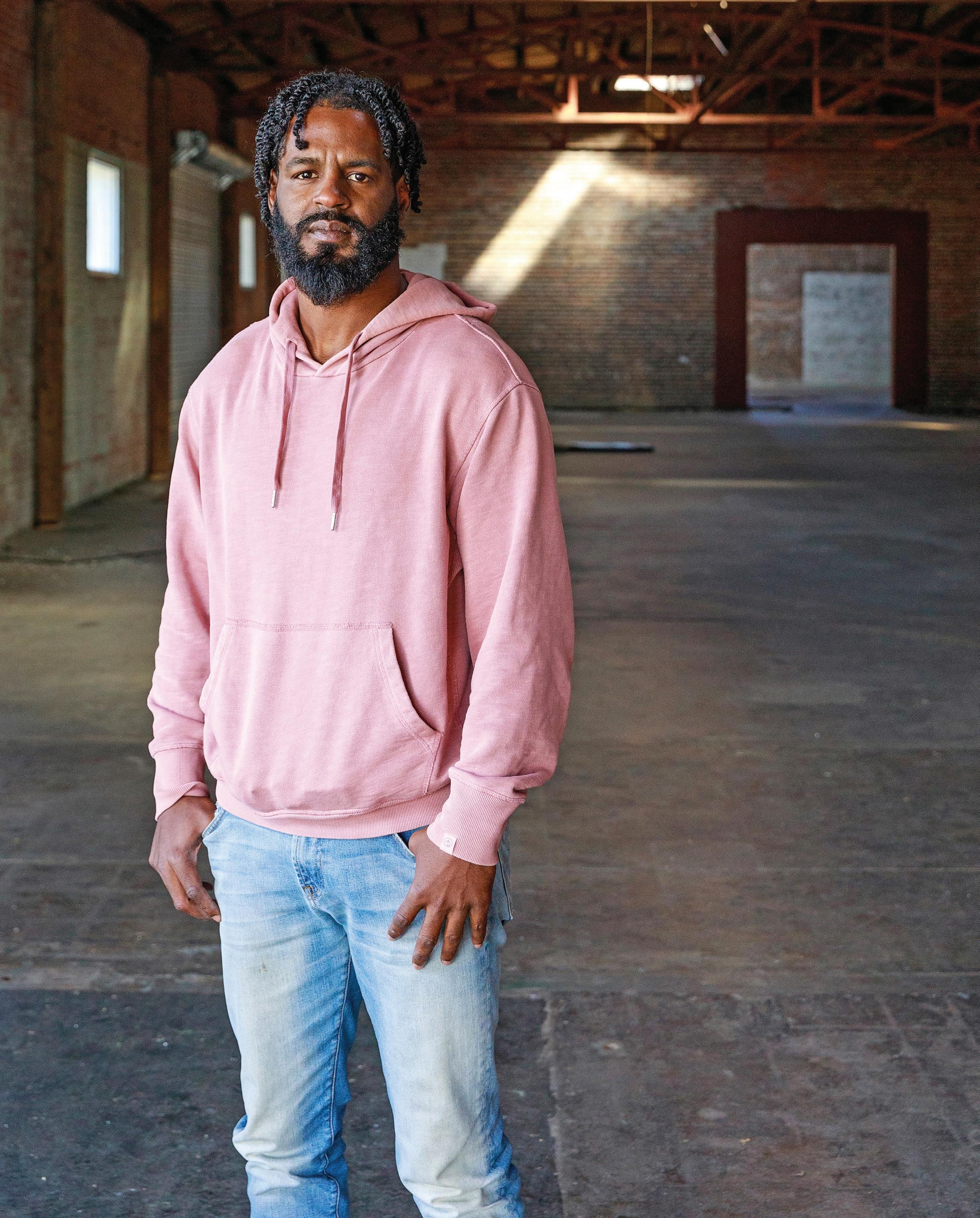
Anthony Kimble
Founder, CEO • Kimble Properties
IT WOULD BE too easy to suggest Anthony Kimble is a successful developer making an impact by helping revitalize north Baton Rouge. In truth, the hometown guy who left to get an education and play football at Stanford has done so much more since his return. His rise—both in community importance and respect—has been meteoric since raising $5 million in 2020 through friends, family and crowdsourcing to invest in the Baton Rouge community. Included in his portfolio is the restoration of the Electric Depot in Mid City as well as renovating houses in largely neglected areas of Baton Rouge and New Orleans. More than bringing residential and commercial properties back into commerce, Kimble also invests his time teaching the value of wealth building, property ownership and financial literacy to those in the traditionally underserved north Baton Rouge community. Perhaps not well known in every circle—yet—Kimble is one of Baton Rouge’s most important voices.
COLLIN RICHIE
Jay Johnson
Chief Financial Officer • Lamar Advertising Company
JAY JOHNSON arrived as CFO of Lamar in October 2019 with significant experience in public companies and—perhaps more importantly—working with capital markets and real estate investors. With Lamar having converted to a REIT five years earlier, Johnson’s expertise and focus on engaging traditional REIT investors—who are typically unfamiliar with out-ofhome advertising—has paid significant dividends for the company. Lamar saw its valuation grow to a record-high of $12.27 billion by the end of 2021, up 48% from the $8.31 billion just prior to his arrival, and as of Dec. 16 sat at $9.54 billion amid a turbulent economic climate. This much is clear: The Bastrop native, who received an MBA from Harvard Business School and a degree in economics from Morehouse College, has been a driving force in the growth of one of Baton Rouge’s most important companies.
GOOD LUCK NOT seeing the name, image or likeness of injury attorney Gordon McKernan around Baton Rouge. He’s everywhere. On billboards. On television commercials. His numerous offices around town are on well-traveled streets, hallmarked by giant flags—including the firm’s headquarters which can’t be missed by drivers slogging along in I-10 traffic. Self-promoting attorneys aren’t exactly new, but McKernan stands out as the very visible face in the new world of college athletics. Since mid-2021 when the rules controlling what student-athletes could earn were suspended, McKernan has gone all-in, signing 39 players (at last count)—including 32 LSU athletes or commitments—to NIL deals. And it’s not just football players; McKernan has agreements with 15 members of the LSU women’s basketball team, making him almost as important to the team’s success as its Hall of Fame coach, Kim Mulkey.
Gordon McKernan
Attorney / Owner • Gordon McKernan Injury Attorneys
COLLIN RICHIE DON KADAIR
Chris Cummings
Founder, CEO • Iconic Moments
CHRIS CUMMINGS IS on a mission to save history—in an innovative way. Inspired by a desire to preserve the stories of his family after his mother was diagnosed with early-onset dementia, Cummings launched Pass It Down in 2015, an award-winning digital exhibit design platform that transforms how museums and cultural institutions engage their visitors. From that venture came Iconic Moments, an NFT marketplace that works with institutions to engage visitors digitally and drive revenue even if the visitor doesn’t enter the building. In short, the company is creating limited-edition NFTs of art and historical records that not only preserve them digitally, but also drive revenue for museums while allowing history to be seen, and shared, by a wider audience. Over the past year, 170-plus institutions—including the White House and the Women’s Suffrage National Monument—from more than 15 counties have either approached or are working with IM. The LSU graduate and a 2022 BREW High-Stakes Pitch winner is also working with Proctor & Gamble, Porsche and Ford Motor Company to bring their respective archives to life. The company is also one of five winners of the United Nations World Summit Award in the category of Best Innovation Globally in Culture and Tourism— and the only winner from the U.S. in any category. In October, IM launched Art Pass, a membership program for the company, and more than 35,000 people signed up for the 1,200 available passes in the first four days.
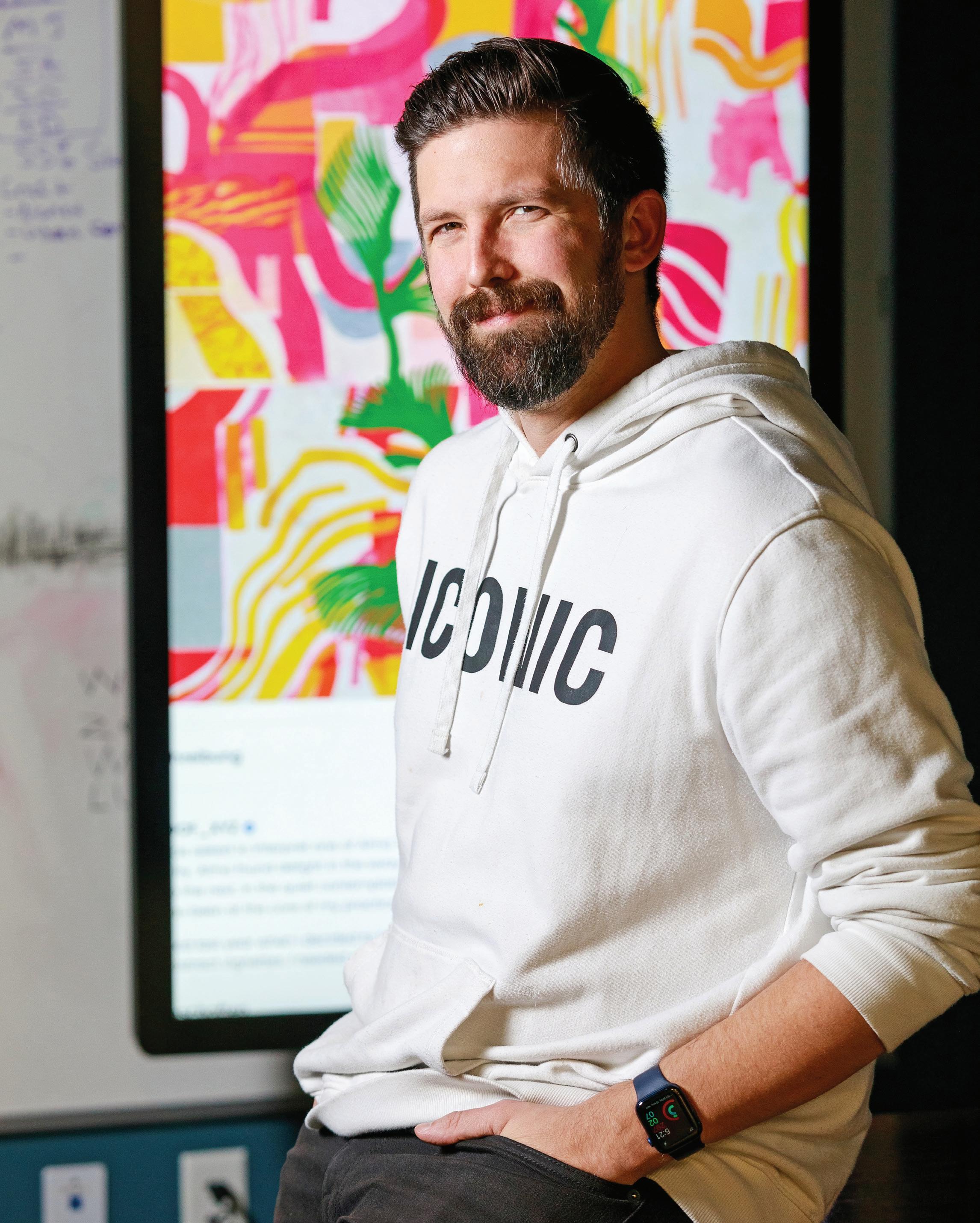

Dai Nguyen
General Manager • Shell Chemicals Geismar
WHEN MOST OF us think about the Shell Chemicals Geismar facility what comes to mind is a slew of multisyllable, hard-to-pronounce words—like “ethylene glycol” and “alpha olefins”—that through the wonder of chemistry eventually become products we use in our everyday life. Yet the Ascension Parish compound managed by Louisiana native Dai Nguyen is much more: It’s also a key facility in the evolution of Shell’s global business model, which not only focuses on netzero emissions and sustainable products but also on working more closely with the communities its facilities call home. Growing up in New Orleans, Nguyen’s parents wanted him to become a doctor. Not wanting to go through the long educational grind he opted instead on chemical engineering. Today, the 32-year Shell veteran—motivated by working outside his comfort zone, new challenges and transformation—is tasked with managing the facility that’s at the epicenter of the company’s strategic plans. Nguyen, an advocate for early childhood education, is also heavily involved in the community, sitting on the boards of the Capital Area United Way, BRAC, the Louisiana Chemical Association and The Arts Council of Greater Baton Rouge.
COLLIN RICHIE
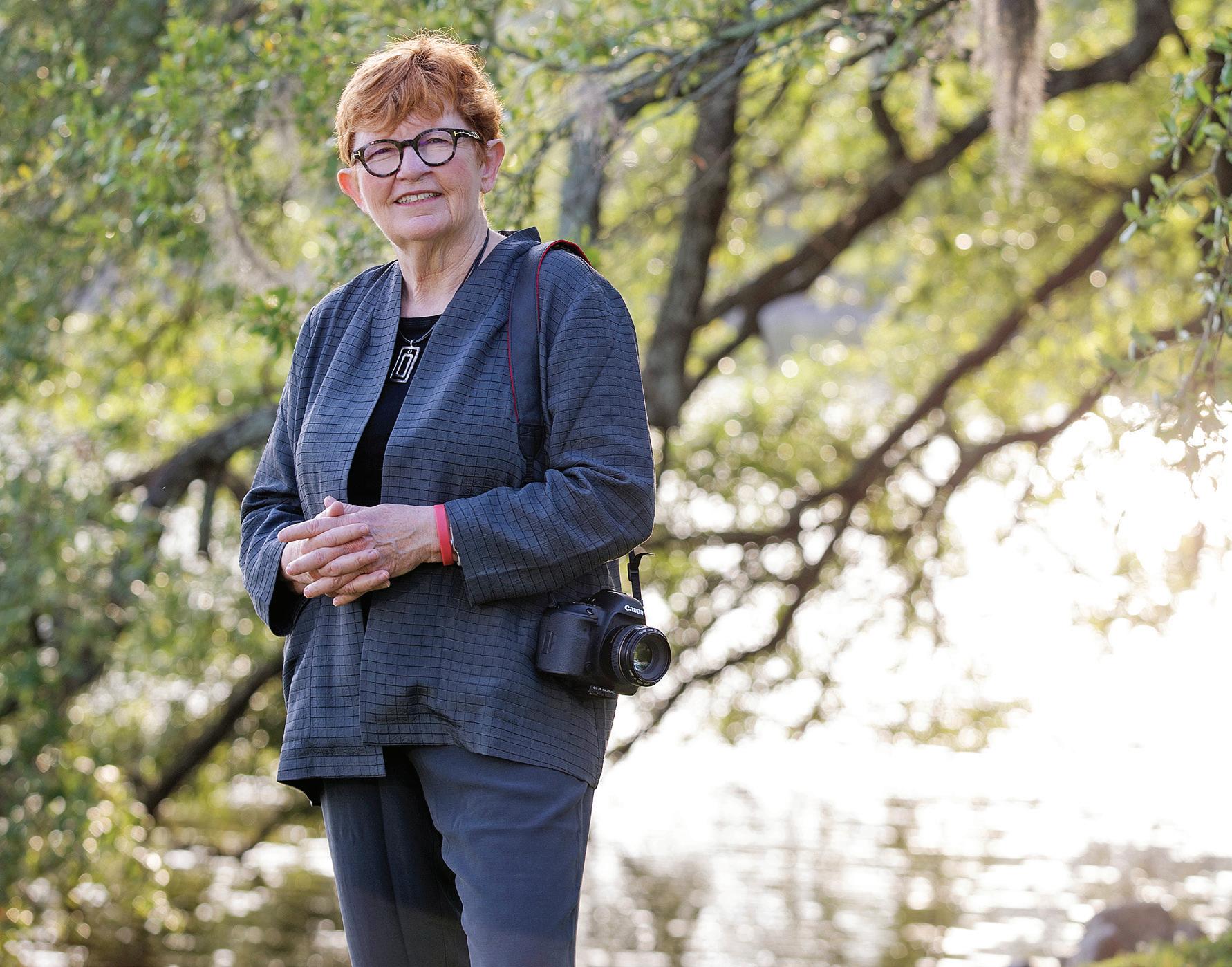
Mike Wampold
Real Estate Developer • Wampold Companies
MIKE WAMPOLD has been making a difference on the Baton Rouge landscape for some two decades, whether it’s taking an eyesore and vandalized abandoned concrete dormitory on one of Baton Rouge’s business thoroughfares and converting it into The Renaissance Hotel, developing downtown’s first spec Class-A office building with II City Plaza or building luxury condos with spectacular lakefront views of LSU. His current projects are equally audacious. Once known at the Chase Towers, Wampold has rebranded them as I & II Rivermark Centre and both will undergo renovation. Though happening in larger downtown settings, Wampold is the first to convert what had been an office tower into a mixed-use I Rivermark Centre, a blend of retail, office and residential. Leasing on one-, two- and three-bedroom apartments located on floors eight through 21 began in September. Equally bold is his mixed-use, quasi-TND Harveston development off Bluebonnet Boulevard near Nicholson Drive. While several phases of the residential side of the project are complete, what makes this project stand out is the scale of the office, retail and commercial projects that will soon begin to break ground. Though Wampold generally prefers to remain out of the spotlight, his resume of impressive residential, multifamily, office and commercial projects makes it hard to keep him off Baton Rouge’s main stage.

Marie Constantin
Citizen Activist • Louisiana Stormwater Coalition
MARIE CONSTANTIN for most of her adult life has been known as an award-winning photographer who, among other subjects, so beautifully captured the image and spirit of Mother Teresa. She’s been on a new mission in recent years: a citizen activist drive to clean up the trash-filled waters around Baton Rouge while emerging as a leading apostle of a comprehensive stormwater management plan as well as more effective garbage trucks in East Baton Rouge Parish. A member of the Louisiana Stormwater Coalition, Constantin has become the public face—and its most vocal advocate—for the cause. And her work, along with that of her fellow coalition members and allies, is having an impact, shining a bright spotlight on our litter problem and its wideranging impact as well as advocating for best-practice solutions.
Dr. Philip Schauer
Professor of Metabolic Surgery and Director Metamor at LSU’s Pennington Biomedical Research Center
IF THERE IS such a thing as rock stars in medicine, then Dr. Philip Schauer is one of them. Known as a pioneer in bariatric surgery and internationally recognized as an expert in the medical fight against obesity and diabetes, Schauer was recruited here in 2021 to work with the Pennington Biomedical Research Center and Our Lady of the Lake Regional Medical Center to put Baton Rouge on the global map in the treatment of obesity and diabetes. A bold goal, no doubt, but why not? Schauer previously played a key role in doing that for the Cleveland Clinic bariatric program, lifting it from nearly last place in Ohio in 2004 to one of the top centers in the world. Prior to his departure, the clinic was in the top 1% in bariatric surgeries performed and tops in the country for bariatric research publications. Schauer believes the program at Metamor has the potential to be larger and more comprehensive than what he helped build in Cleveland. Not only does Louisiana have the highest rate of severe obesity in the U.S., but the strategic plan calls for the facility to be a national and international destination treatment center. A gastric bypass procedure pioneered as a result of research done by Schauer—who has performed more than 8,000 operations for obesity and diabetes—showed that as many as 83% of patients with diabetes can go into full remission after the surgery. Not enough? On the immediate horizon is the opening of the first comprehensive pediatric obesity center in the state, in collaboration with OLOL, as well as the availability of new obesity medications, many of which, Schauer says, were tested at Pennington.

COURTESY POSTLETHWAITE & NETTERVILLE

Jennifer Butler
Director of Disaster Management and Recovery • Postlethwaite & Netterville
JENNIFER BUTLER was given a first-year target goal after being hired for a newly created position by Postlethwaite & Netterville in 2020 to grow the firm’s existing disaster management and recovery business. Ten months into the job, Butler obliterated the projected number, landing business above that undisclosed number by a four-figure percentage. Recognized as an expert in the disaster recovery field, Butler has spent nearly 20 years in leadership roles with organizations dedicated to preparing for, mitigating and recovering from natural and man-made disasters, including a stint with the Water Institute of the Gulf. No doubt, Butler and her team are an asset for P&N, yet also provide another economic growth opportunity for Baton Rouge. The Capital Region, along with south Louisiana, is known as a national—and often international—leader in numerous areas of disaster and crisis management and Butler is opening another avenue of excellence that aids those in crisis, boosts the bottom line and provides new economic opportunities for the area.
Dr. Gunjan Raina
Concierge Medicine • Heal 360º / MDVIP
THE ONLY FEMALE concierge physician in Baton Rouge, and one of the youngest in the country, Dr. Gunjan Raina is taking a pioneering approach to medicine—and not simply because she’s working in the semi-nascent field of concierge medicine, where patients pay a fee for various conveniences like same-day appointments and 24/7 physician availability. What makes Raina different is the crusadelike mission she’s on to counsel, educate and, when necessary, cajole her patients into leading a healthier physical and emotional lifestyle. As one patient says, “She’s an all-in physician with a passion.” Patients say this is the benefit of having such a close relationship with their primary care doctor, suggesting the $1,800 annual fee is more than offset by a healthier way of living that reduces other medical expenses. Raina, who advocates for vegan and alcohol-free living, is carving out a niche fighting obesity not only with her patients but also through her efforts across the community—as well as in India and Canada where she also practices.
COLLIN RICHIE










